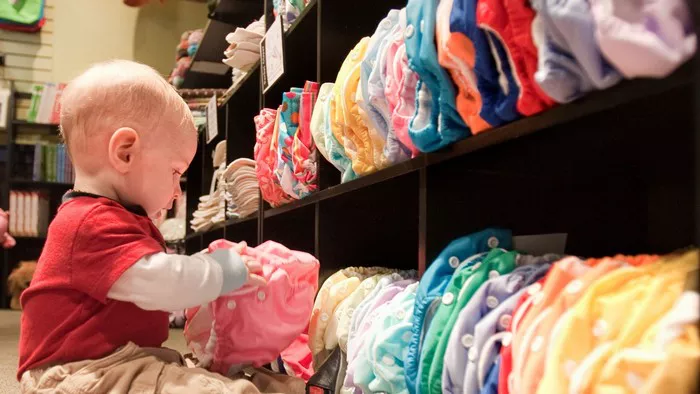Cloth diapers have emerged as a popular choice among environmentally-conscious parents seeking economical and gentle alternatives to disposable diapers. Choosing cloth diapers for your newborn involves understanding the various types available, how to use them effectively, and maintaining them for long-term use. This comprehensive guide provides detailed insights into the world of cloth diapering, ensuring you’re equipped with all the necessary information to make an informed decision.
Understanding Cloth Diapers
Cloth diapers come in several types, each offering unique features and benefits tailored to different preferences and needs:
1. Types of Cloth Diapers
Prefold Diapers: Rectangular-shaped diapers that require folding and securing with pins, clips, or covers.
Fitted Diapers: Contoured diapers with elastic around the legs and back, often fastened with snaps or hook-and-loop closures.
Pocket Diapers: Feature a waterproof outer layer with a pocket inside where absorbent inserts are placed.
All-in-One (AIO) Diapers: Similar to disposables, AIO diapers have absorbent layers sewn into the waterproof cover.
All-in-Two (AI2) Diapers: Consist of a separate waterproof cover and snap-in inserts, allowing for customizable absorbency and easier laundering.
2. Benefits of Cloth Diapers
Environmental Sustainability: Reduce waste in landfills compared to disposable diapers.
Cost-Effectiveness: Long-term savings, especially with multiple children or when diapers are reused.
Health Considerations: Natural fibers may reduce the risk of diaper rash and sensitivity reactions to chemicals found in disposables.
Getting Started with Cloth Diapers
Preparing Cloth Diapers
Before using cloth diapers on your newborn, it’s essential to prep them properly to enhance absorbency and durability:
Prepping Process: Wash new diapers multiple times according to manufacturer instructions to remove natural oils and increase absorbency.
Choosing Inserts: Select inserts or boosters suitable for your baby’s needs, such as hemp, bamboo, or microfiber, depending on absorbency requirements.
See Also: Can You Use Aquaphor on Newborns: Things You Need To Know
Using Cloth Diapers
Using cloth diapers effectively involves mastering the techniques for changing, securing, and maintaining them:
1. Changing Routine:
- Change diapers every 2-3 hours or as soon as they are soiled to prevent leaks and discomfort.
- Use a flushable liner or disposable liner to catch solid waste, making cleanup easier.
2. Securing Diapers:
- Ensure a snug but comfortable fit around your baby’s waist and legs to contain leaks.
- Adjust the diaper size and fastenings (snaps, hook-and-loop closures) as your baby grows.
3. Absorbency Management:
- Choose diapers with appropriate absorbency levels for daytime and nighttime use.
- Add extra inserts or boosters for overnight diapering to prevent leaks and ensure dryness.
4. Nighttime Diapering:
- Use diapers with higher absorbency or insert additional layers (such as doublers) for extended overnight protection.
- Consider using wool diaper covers for added breathability and leak resistance during nighttime use.
Care and Maintenance of Cloth Diapers
Proper care and maintenance ensure your cloth diapers remain clean, absorbent, and in good condition for extended use:
1. Storage Practices:
- Store soiled diapers in a dry pail or wet bag until wash day to prevent mold and odors.
- Rinse heavily soiled diapers under cold water before storing to minimize stains and odors.
2. Washing Routine:
- Wash diapers every 2-3 days using a cloth diaper-friendly detergent that is free from additives, fragrances, and fabric softeners.
- Follow manufacturer guidelines for water temperature and wash cycles to maintain diaper performance and longevity.
3. Drying Methods:
- Line dry diapers whenever possible to prolong elastic and waterproofing integrity.
- Use a low-heat setting on a dryer if needed, avoiding high heat to prevent damage to fabrics and closures.
Troubleshooting Common Issues
Addressing common challenges ensures a smoother cloth diapering experience:
1. Leak Prevention:
- Check diaper fit and adjust as needed to prevent gaps around the legs or waist.
- Ensure inserts are properly placed within pocket diapers or secured in AI2 systems to maximize absorbency.
2. Odor and Stain Management:
- Sunning diapers can naturally bleach stains and eliminate lingering odors.
- Use diaper-safe stain removers sparingly and rinse diapers thoroughly to remove detergent residues.
Tips for Success with Cloth Diapers
Maximize your cloth diapering experience with these practical tips and strategies:
1. Start with a Trial: Experiment with different types and brands of cloth diapers to find what works best for your baby’s comfort and your lifestyle.
2. Establish a Routine: Create a consistent diapering and laundering routine to streamline the process and maintain diaper performance.
3. Community Support: Join online forums or local groups to connect with experienced cloth diapering parents for advice, troubleshooting, and support.
Conclusion
Cloth diapering offers a sustainable, cost-effective, and gentle alternative to disposable diapers for newborns. By familiarizing yourself with the types, usage techniques, and maintenance practices outlined in this guide, you can confidently embrace cloth diapering as a rewarding choice for your baby’s comfort and well-being, while contributing positively to environmental conservation efforts.


